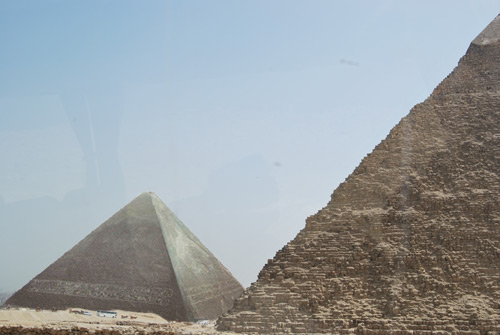Intro.
The Pyramids are truly impressive, however we must make an effort to imagine how they were originally, now the monotonous color of the sand, does not give us no clue, neither the unforgivable sellers of souvenirs , nor camels, much less the absurd multicolor procession of tourists. Herodotus describes the land of Egypt during the four months of the flood, like a sea, where the cities were like islands. Assuan´s Dam ended with the endemic epidemics and crocodiles, but stole his magic to the Nile. The pyramids were part of a funerary quadrangular complex , designed as a city with buildings, streets and a canal that brought water from the Nile, so it is possible imagined that the whole should be adorned with gardens. Neither Herodotus nor Diodorus of Sicily made mention about the huge fourth pyramid, maybe because it was separated from the rest or perhaps because it had been already swallowed by the desert or maybe the Persian conquerors built the fortress that would give rise to Cairo with “the bowels of Atum-Ra”, “the elemental hill” that was erected by Djedefre, seven meters and a half larger than the Great Pyramid.
We would have only two hours to try to visualize all this while we trying to get rid of the, always inopportune, vendors of beetles and turbans , besides the omnipresent police, most of them inanimate except the few unfortunate ones they were responsible for the endless task of down to the people of the enormous stone steps, where people were climbed continuously to take pictures, and is that the portraits with the pyramid to the bottom do not provide a precise idea of the volume of such pile of stones.
The awesome Sphinx controls the access to the funerary complex of Gizah, despite of Herodotus never made mention of it, may be it was covered with sand, in the times of Tutmosis IV just the head was free of sand. On the one hand, official arqueologists accept the -7500 as the date of manufacture and the king Khefren as its author. However, a curious group of specialists (the Professor Hawass does not want to hear about them), basing on the observation of certain signs of erosion, apparently caused by the rain, they take back until the -12500 the date on which it was carved,when certainly still rain frequently there, what is not happens at present. they have provided indirect evidence of astronomical kind, to support by the moment their rickety theory, which link the alignment of the three pyramids with the alignment of the stars of Orion’s belt, and also claim that the Sphinx look at the East because it was where the constellation of the Lion appeared in -12500. Moreover there are eminent archaeologists who see the features of Kheops on the head and not those of Khefren, opinions for every taste.
II.
The called the Old Empire begins with Menes, or Narmer or Aha, or it may be that they were all the same person, the kings had the habit of having different names, one of Horus, one nisut-bity (king of the south and north), and a few more besides the grand honorary names.
There are lists of kings, as the papyrus of Turin, or what provide us Manetón, but archeology has shown that they are not very accurate, although it seems to be some consensus and for the beginning of the dynasty was accepted as the approximate date -5000. the I and II dynasties, used all its efforts on maintaining the cohesive of the two lands , but neither the feudal princes of the South nor the bourgeoisie of the cities of the North, put it easy. Initially the kings tried to keep the primal institutions in each region, in the vain attempt to maintain an image of normalcy, until in the reign of King KhaseKhemui, things get ugly. As he ventured on an expedition to Nubia, the feudal prince of Nubt, Peribsen, taking advantage of his absence, was made to proclaim king and Egypt was divided in two, one more time. The war that claimed tens of thousands dead, was won by KhaseKhemui, after which he proceeded to exclude the feudal princes from the political scene and controling the bourgeois through intendants real. Heliopolis remained a sacred city, but the monarchy will no longer require its approval, to legitimize his own power.
The institutions of both North and South were emptied of contents and filling the resulting skeleton administrative with people associate to the king. Over time administrative model of the North also ended up being used in the South.
Besides the solar cosmogony of Heliopolis which dates from the era of the kingdom of Buto, the Thot´s cosmogony survives in Hermopolis , somewhat different, more physical and perhaps more ancient, still influenced by the Asian cosmogony. Solar religion reveals that in the primordial chaos (Nun), although anything had been created yet, Atum, however, was already diluted on it , as the power of generating or the spirit of life, then after recognizing to itself , came to existence, for later, unfolding to itself , to give rise to the god Ra, the concience of Atum.
Atum-Ra created the air (Shu) and the fire (Tefnut) of whose union was born the god Earth (Geb) and the goddess of sky (Nut), parents of Osiris, Isis, Seth and Neftis, two couples who come to signify the principles of good and evil. Nine gods in total, the Ennead of Heliopolis clearly syncretistic is a real jumble that somehow summarizes the various stages through which society had to pass since its inception. Osiris besides of representative of the goodness assumes the role of creator of humanity and all life, also he is Nepri, god of grain, provider of new life, symbol of the resurrection although his main role is the king of beyond, in fact one of his epithets is “The first of the Westerners”. The myth of Osiris is very well known thanks to Plutarch, the legend of this god-man developed since the beginning of the Predynastic period, it seems clear that not only reflects the differences between gods, but also those of the ancient kingdoms of the north and south, also summarizes the close relations between Egypt and coast of Syria from the early times.
In Hermopolis, Thot, into the role of the god Atum, is surrounded by four couples of gods: Nunu and Nunet symbolizing the primal water, Kaku and Kaket, darkness, Hehu and Hehet, space, Niu and Niut, immobility, curiously the elements male and female are represented as frogs and snakes, respectively. The representation of the chaos that contains to Atum (Thot) is a swamp, from which arises a primal hill, on which there is an egg, from where arises the Sun. is a version with evolutionary dye, where things become each other, that differs from the version of Heliopolis, where Ra is the creative will. The idea of the supremacy of Ra was spreaded rapidly, primarily to replace the influence of Horus in the pantheon of gods, too tied to the still recent quarrels between the two lands, in addition, this philosophy was interesting to the royalty, more and more inclined towards absolutism, although however the Kings never left the cult of Horus.
During the III dynasty, was stablished a complex bureaucratic machine, the Civil Service is in itself a new power within the state, and the most senior bosses, over time will acquire the status previously held by the nobility. As for the priests of Heliopolis ended up being appointed directly by the king, may be the case of the legendary Imhotep, chief architect, chancellor (maximum office of the state) of the famous king Djeser and High Priest of Ra. They begin the era of the pyramids builders. By then it was began to use the cartridge (shenu) to contain the royal names.
All workers recruited by the state were free men, with all rights and obligations, only prisoners of war were considered slaves of the king, it seems that law and morality in this respect was very strict, it seems that we can affirm that during the Old Empire did not exist slavery in Egypt.
In Memphis which became a great religious center at the expense of Heliopolis, under the auspices of the monarchy, there was developed a new doctrine, consistent with the ambitions of royalty, in which, Ptah assumed the role of Atum-Ra in the diagram of the solar cosmogony and where in fact all the gods were aspects or avatars of Ptah, emanated from him. From trend monotheistic, shows a remarkable depth, handling concepts like the intelligence or discernment (sia) represented by Horus, the determination or decision (hu) symbolized by Thot, and where Ur (Atum) ancient god of the universe was the heart (the intelligence) and tongue ( the will) of Ptah. Memphite Theology permeated the thinking not only of Egyptians but of the presocratic greek philosophers, and through them to the modern world.
To Snefru, who inaugurated the Fourth dynasty are attributed the crooked pyramid from Dahchur (near from which, Huni had built, shortly before the end of the III Dynasty) and the tower of Meidum clearly influenced by Asian style. While Snefru King will be remembered as a person gentle and humane, his son Cheops (Chufu) go down in history as a tyrant and a despot if we have to believe to the Memphite priests, during his tenure there was a radical break between the clergy and the palace, reaching even to be closed the temples. At this point of absolutism, the royalty is divinized, the king is Ra incarnate, and by extension, the senior management, would become great priests: judges will be priests of Maat (justice), the head of administration will be high priest of Thot (the Law, the Act), etc.
Still is discussed the authorship of the great pyramid of Giza, due to the shortage of evidence that confirm it, only has been found a squalid cartridge painted on a place hidden inside the pyramid, containing the name of Cheops, only physical evidence if we do not take account the testimony of Herodotus, whose on the other hand Diodorus of Sicily contradicts. However, under excessive ego of Cheops, it is plausible to believe that he was the author of such a bunch of stones. The conflict with the clergy, was continued during the mandates of the sons of Cheops; Khefren (Khafra)and Djedefre, but it was relaxed with Hordjedef (who became a vegetarian and chaste, in a moment of lighting, then he wrote a “Sebayt“) and Baufre. Micerinos (Men Kaure) son of Khefren , returned to the pleasure of building pyramids, but his son Shepseskaf tried a revolution, abandoning the name of Ra, the cartridge, the pyramid and all you have to do with solar worship, maybe permeated by the Memphite philosophy, developing a policy of equality both in religious as well as the social, which earned him to be more hated by the upper classes that Cheops himself, though his memory among the most popular was near from the authentic devotion.
Bibl.: Jacques Pirenne, ” History of Ancient Egypt”.

